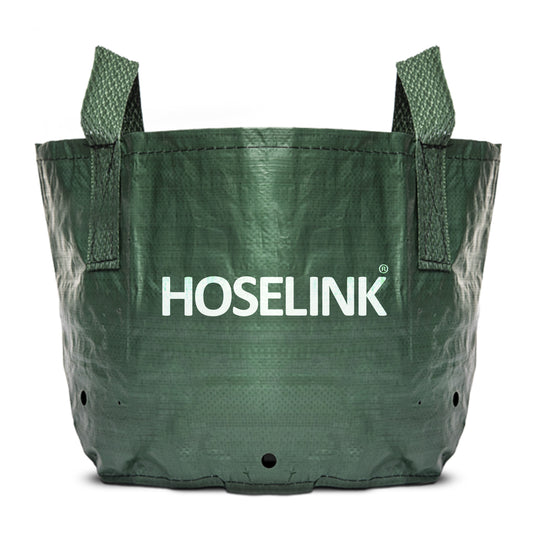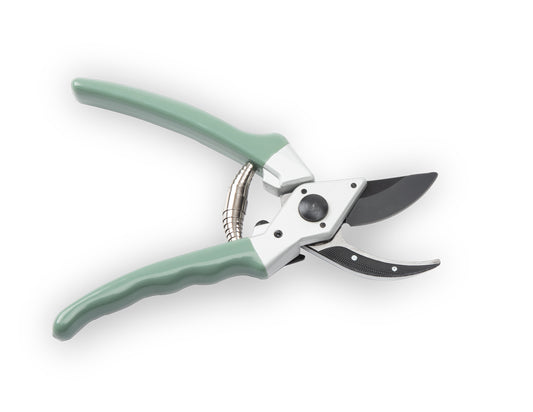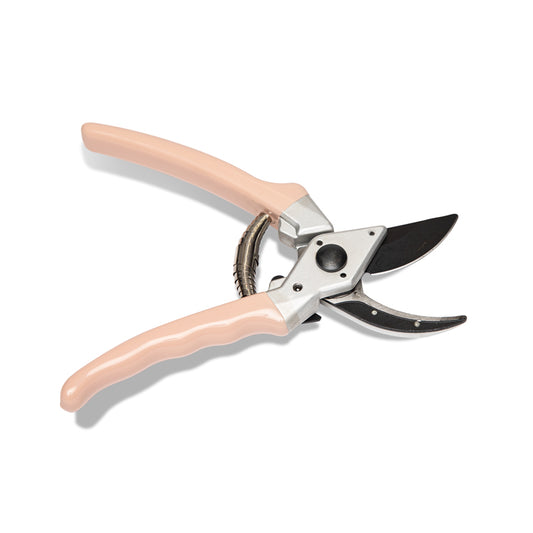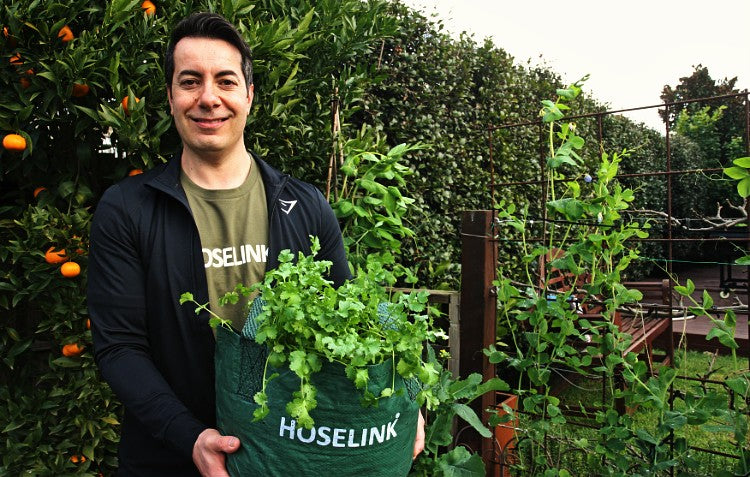I live on a standard inner-city suburban block and my available growing space is both limited and very precious to me. I am always on the lookout to find more available space to diversify the range of edibles I can grow. Hoselink’s Heavy Duty Planter Bags have been the perfect solution and have allowed me to grow more produce in new soil all year round. They are a very effective alternative to plastic pots or containers and provide so many growing benefits. In this article, I will be running through some of these benefits as well as outlining some edibles that thrive using this versatile and practical application.
Why Use Planter Bags?
Whether you like growing vegetables, herbs or fruit trees, there are many benefits to growing edibles in planter bags. They are very affordable, versatile, transportable, promote plant health and are an excellent option if you are restricted on garden space or have relatively poor soil. Planter bags can be used anywhere outdoors including decking areas, balconies and courtyards, and they also offer the perfect solution if you live in an apartment or a rental property. If you are buying a home or are in the process of shifting to a new house, planter bags allow you to take part of your garden with you when you relocate.
The bags are light weight and easy to lift and move around to suit the climatic conditions of the plant you are growing. The heavy-duty handles make this process a breeze as the bags weigh virtually nothing; it is the soil content and the plant itself that dictates the ultimate weight of the planter bag. The planter bags are particularly useful if you wish to grow a plant in a protected area and relocate it outside once it has matured. If the plant you are growing is frost or sun sensitive, you have the ability to relocate it to prevent the plants being stressed or damaged by the elements.
The bags are also very useful as a handy garden waste carrier; I like to use them to transport fresh compost to my vegetable garden from my composting area. You can grow seasonal produce in them all year round and simply fold them up and pack them away when they are not in use.

Heavy Duty Planter Bag

Plant benefits
Hoselink’s Heavy-duty Planter Bags are made from non-toxic materials and promote superior aeration and drainage, creating a healthy environment for root growth and overall plant health. In traditional pots, roots generally overgrow in circles, eventually entangling themselves. Once the roots hit the edge of hard pots, they tend to keep growing to search for more water and nutrients. This can eventually lead to a sick and root-bound plant if not properly managed or repotted into a larger container. This is where the Planter Bags come into their own! Root-bounding is unlikely to occur in planter bags; the point of difference is that once the plant roots touch the bag’s soft perimeter, they will come into contact with drier soil and be exposed to more air. Instead of roots bounding and entangling themselves, they will simply stop growing – this is known as air pruning. Once the roots are air pruned, it will encourage the plant to throw out new roots from its base. This will effectively build a robust and healthy root system with a network of smaller root tips, which will lead to improved nutrient and water uptake, and ultimately a much healthier plant. The flow-on effect from this leads to improved plant vigour and promotes the ability to produce better yields.

Soil recipe for success
Healthy soil is one of the most important aspects of growing any edible, this is also the case when growing edibles in containers or Planter Bags. Unlike growing plants directly in the ground where it is easier for the plants to find and uptake nutrients, you need to build and provide this in containers, which requires a little more work. You certainly never want to use ordinary garden soil; this will have a tendency to harden off and bind together, causing the roots to suffocate, leading to extremely poor aeration and drainage. You need to invest in the best possible soil mix you can afford that is suitable for growing edibles in pots or containers. I like to add additional organic matter and ingredients to promote soil health and to improve soil aeration and drainage.
My soil recipe:
- 60% premium quality potting mix intended for growing edibles in containers. Don’t buy the cheap potting mix, buy the best possible product that you can afford. Ensure there are some chunky wood chips or bark in the mix to aid in aeration.
- 10% mix of coconut coir - This helps to increase aeration and retain moisture. Coir is known to hold up to 10 times its weight in water. It is also easy to find at your garden centre and has a neutral PH.
- 15% rotted animal fertiliser or compost to boost the nutritional qualities of the soil and provide consistent nutrients for the plants across their growing cycle.
- 15% perlite – This looks like small white soft Styrofoam balls and is a natural occurring mineral with the ability to hold some water while allowing excess water to drain away. It also helps to open the soil and improve aeration. Vermiculite can be used as a substitute for perlite.
It is a good idea to apply a top layer of mulch in the warmer months to help retain moisture and prevent the top layer of soil from drying out. I like to use hay, pea straw or fresh compost and apply it at about 3cm thick.

Secateurs 225mm | Peach

Secateurs 225mm | Peach
Fertilising plants and ongoing care
Planter Bags do not contain as much soil as a natural garden does. Edibles that are heavy feeders will require human intervention and manual feeding to maintain a steady supply of essential nutrients. I like to sprinkle a small handful of animal manure pallets and water it in with Hoselink’s Seaweed Tonic solution once a month. You can also use blood and bone, worm castings, or make your own compost tea as a monthly fertiliser additive. In addition to this, I also liquid feed my plants fortnightly with Super-Grow Garden Fertiliser Concentrate and alternate each time with Plant Health Seaweed Tonic. This helps to promote higher yields and optimises plant health; ultimately a healthy plant helps ward off pests and diseases. They are also less susceptible to frost or heat stress.
Sizing and plant suitability
There are three Planter Bag sizes available in the range:
- 25L – 34cm diameter base x 28cm high (small)
- 45L – 38cm diameter base x 40cm high (medium)
- 100L – 51cm diameter base x 50cm high (large)
The small bag is ideal for smaller single plants or various kitchen herbs such as parsley, coriander, basil or mint. Some other edibles that will thrive include strawberries, lettuce, silver beet and kale.
The medium pot size works well for a wide range of edibles such as tomatoes, capsicum, chillies, eggplants, brassicas, root crops, and dwarf fruit trees, as well as flowers.
The large bag can accommodate multiple plantings and larger varieties such as potatoes, tomatoes companion planted with herbs, multiple strawberry plants, zucchini, squash, pumpkin and small or dwarf fruit trees. They also work well for multiple plantings of salad greens, beans, cucumbers and peas.

Secateurs 225mm | Peach

Secateurs 225mm | Peach
Additional considerations:
Tomatoes: They are best grown with a sturdy support ideally using a durable frame or tomato cage. The structure is best installed at planting stage, when the roots and plant are small, to prevent root damage or bruising once the plant has matured. Tomatoes can grow up to two metres in height and need lots of support, particularly when they are loaded with fruit on hot windy days.
Potatoes: This is a brilliant crop to grow in Planter Bags given they have a long (3-4 month) growing season and can take up valuable space in your garden. Fill the bottom of the bag with approximately 6cm of soil and add in the potatoes at the recommended spacing. When the plant reaches approximately 30 cm of growth above the soil, add more soil to cover the bottom half of the plant. It is OK to cover the lower leaves. When the potato plant has grown an additional 25-30cm, repeat the previous process. Potatoes are generally ready to dig up when the plants foliage begins to die off.
Herbs and lettuce: Grow ‘cut and harvest again’ varieties near to your back door, provided they receive at least six hours of sun per day there. It is very convenient to grow herbs and salad greens in close proximity to your kitchen to enable fresh harvests while preparing meals.
Strawberries: Strawberries can be an invasive plant given their growth habit is to reproduce new runners and multiply in the garden. This is why they are best grown in containers to prevent them from taking over your garden beds. Mulch them well with hay or pea straw to prevent your fruit touching the soil and rotting. It also helps to retain moisture levels. Replant your strawberries every season by transplanting new strawberry runners and replenish at least half or all the soil on an annual basis.
Peas, beans and cucumbers: These climbing varieties will require a sturdy vertical structure. Try making a DIY trellis out of bamboo stakes and secure together with twine at the top. Cheap fencing wire or builder’s mesh can also be bought and cut or manipulated to size to use as a good support structure.
Fruit trees: Ensure fruit trees are pruned at least annually to maintain a manageable height and shape. Feed them with a complete fertiliser at the change of every season and liquid feed them monthly with a complete fertiliser, alternating with a seaweed tonic each time.
Going on vacation: If you plan on going away for a few days during the warmer months, water your plants well and relocate them to a shady and protected area. This will prevent the soil drying out and your plants going into shock or dying. If it is a holiday over an extended period, kindly ask a friend or family member to water them at least every two to three days.









